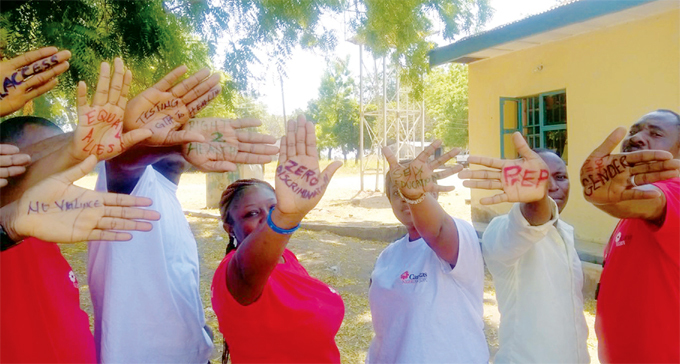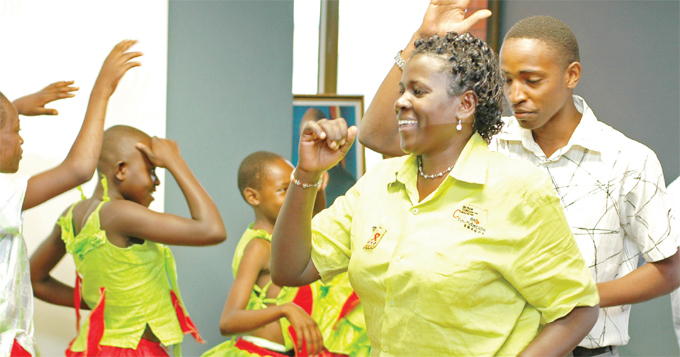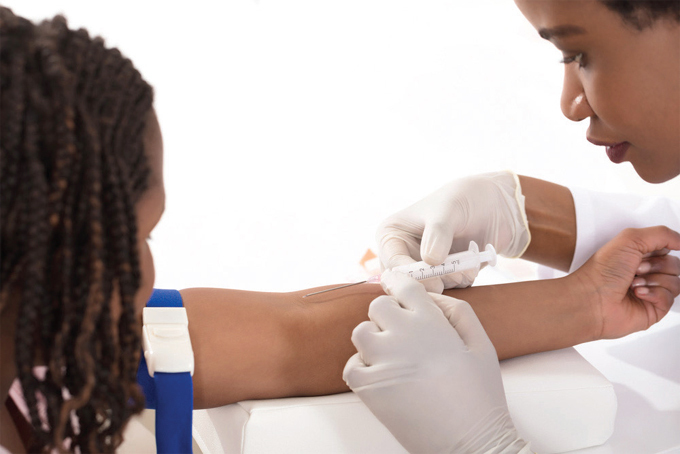World Aids day
Reaching girls, young women and men to curb HIV infections
Reaching men, girls and young women to reduce new infections
By Elvis Basudde
With 540 young women between the age of 15 and 24 getting infected with HIV every week, there is cause to worry. The above statistics translates to two young women getting infected with HIV every hour.
According to experts, unless something fundamental is done to reverse the trend, more girls and young women will be infected in the days ahead.
When it comes to men, regrettably, many are not going for an HIV test, so many do not know their serostatus, which is a dangerous position to be in. As Uganda joins the rest of the world to commemorate World AIDS Day.
It is an opportunity for people to unite in the fi ght against HIV, to show support for people living with the virus, commemorate and mourn those who have died from an AIDSrelated illness.
 There are still several bottlenecks in the HIV/AIDS fi ght, such as reversing new HIV infections the majority of which are among young people that need to be addressed
There are still several bottlenecks in the HIV/AIDS fi ght, such as reversing new HIV infections the majority of which are among young people that need to be addressed
This year's global theme is Right to Health and the national theme is: Reaching men, girls and young women to reduce new HIV infections.
The venue for the national event is Kole district. According to the acting director general of the Uganda AIDS Commission, Dr Nelson Musoba, the selection of the national venue is premised on addressing the vulnerabilities that fuel HIV infection in the community.
Kole district is situated in northern Uganda, which is a high HIV prevalence region. It lies on an international highway linking Mombasa in Kenya to Juba in Southern Sudan with emerging hotspots along the way and it is a post conflict area.
Musoba says the national theme is in line with the main area of focus for the Presidential Fast-Track-Initiative on eliminating the scourge of HIV/ AIDS in Uganda by 2030.
The initiative which was launched in June follows concerns by the President about the increasing prevalence of the killer disease in the last few years, despite tremendous achievement in the past. CLICK HERE FOR MORE ON THIS STORY
UNAIDS boss: Fast-track HIV response
The world has set an ambitious goal of ending AIDS by 2030. As we mark World AIDS Day, Richard Wetaya asked the Joint United Nations Programme on HIV and AIDS (UNAIDS) country director Karusa Kiragu, how Uganda is performing in this regard and what needs to be done to make the aspiration a reality among other related issues
In your assessment, how is Uganda performing in keeping with the UNAIDS' declaration on ending AIDS by 2030?
Uganda is making considerable progress, but the fact that there were 52,000 new infections in its population last year means there is still a lot of leeway to be made. The 52,000 translates into 1000 people a week and that is a huge number of infections. It is not a number to be comfortable with. In order for Uganda to reach the 2030 goal, there is need to fast track and accelerate the response and in many respects, that is what is being done with the Presidential Fast Track Initiative. If you look at new infections among children, Uganda did very well. New infections reduced from 40,000 in 2009 to 4,600 now. That is a reduction of about 90% and that puts Uganda on track in as far as ending infections among children is concerned.
How best can we scale up the empowerment of vulnerable young persons in Uganda with actionable information on HIV?
Information is definitely the key to controlling an epidemic. What is needed to empower young people is to ensure that they have appropriate information for their age. Young people need information and services. They need an enabling environment in health care; an environment devoid of discrimination and stigma. Giving information tailored to different age groups is very important. That is why UNAIDS is pushing for sexuality-based education to be reinstated in schools after its ban last year. CLICK HERE FOR MORE ON THIS STORY
Baylor's teacher Jane wins award
It all started with a chance encounter at a suburban church in southern Kampala. School teacher Jane Beyeza was acting as an usher when she got into conversation with a stranger who did not want to enter but continued to pray from the entrance.
In their conversation, she learnt that he was a foreign doctor training medical workers who were responding to HIV/AIDS challenge in children at Mulago and he suggested she passes by when she gets time to see the big task on their hands. That was in 2004.
Ward 15
Teacher Jane found time the following week to visit Ward 15, which, then was the centre of action at Mulago and she was struck by the whole atmosphere where something was defi nitely wrong in her sight as a teacher.
For Teacher Jane, any group of children together are supposed to be playing and chattering away. But the dozens of children she found at Ward 15 were all sad and looked depressed, even though most were not visibly sick.
This to her was an emergency and without any further delay, reacted by getting down to work, trying to engage the children. Like she would at her then work place Alpha and Omega School on Busabala Road, Teacher Jane asked the children questions, telling them a story or two.
 Beyeza during one of the sessions at Baylor College of Medicine Children's Foundation in Mulago
Beyeza during one of the sessions at Baylor College of Medicine Children's Foundation in Mulago
Time passed and by the end of the day, she hadn't made much progress though it was clear that there was a lot that needed to be done here. First of all the kids' parents themselves were quite hostile. Why should a stranger be talking with their children? Some harshly called them away.
The kids themselves, already traumatised, were not easy and some did not even respond. All these just kindled the fi re of determination in Teacher Jane and returning the following day, she was more prepared and systematic in her approach. The response of the children this time more signifi
cant. She told them stories and they listened. She led them in sing and they sang. And then the great reward that only a person who has ever anxiously nursed a sick child knows, they smiled! Getting Teacher elated, Jane delved deeper into the newfound obsession with making the children happy.
The parents who had to bring the children for treatment also started fi nding Teacher Jane's distraction quite welcome. Many started feeling the reward of seeing their children smile, a much unexpected occurrence at the unfriendly ward.
The parents started sending the children to join Teacher Jane in the small open space where she was conducting her play and story-telling sessions. CLICK HERE FOR MORE ON THIS STORY
Handling hepatitis B in people with HIV
A mother recently delivered her second child, at a Kampala hospital. While the doctor stitched her up, he accidently pricked himself.
In panic, he left the mother without waiting for the anesthesia to wear off, to access a prevention vaccine for hepatitis B. In shock, the caretakers wondered what could be amiss.
It is later that they were informed that their patient had hepatitis B. In addition, the baby needed to start medication for the same. While Hepatitis B is not one of the routinely screened diseases, its transmission is 10 times higher than that of HIV.
According to Dr Mark Mugalu of Crane Health Services, one can acquire both HIV and hepatitis B, if one has unprotected sex. "If you have HIV and continue to have unprotected sex, you can also contract Hepatitis B. The severity of hepatitis B is worse if you have HIV," Mugalu says.
Apart from the sexual transmission of hepatitis B, there is also drug-induced hepatitis B. According to Mugalu abuse of drugs like paracetamol (panadol) can induce it. He explains that from the many strands of hepatitis (A, B, C, D, E), hepatitis B is the most common.
It is transmitted through body fluids; semen, saliva, sweat, blood, cerebral spinal fluid. For instance, if one comes in contact with the sweat of a person with hepatitis B and their skin is damaged, they may get infected.
 Early testing and treatment of hepatitis B will suppress the virus and prevent damage to the liver
Early testing and treatment of hepatitis B will suppress the virus and prevent damage to the liver
Managing HIV and hepatitis B
Mugalu says after being diagnosed with hepatitis B, one should establish if it is acute or chronic hepatitis B.
"The reason for the additional test is to establish the viral load. If found low- below 1,000copies, it is considered chronic. This means that it does not give symptoms at the moment. To such a person, the body is given a chance to fight the virus. However, when found to have more than 1,000 copies, treatment is necessary. This is because the body will have symptoms, including general body weakness, fever, sweating, tenderness in the right upper quadrant of the stomach, yellowing of the skin, eyes, mucus membranes, passing yellow urine and abdominal pain," Mugalu says.
He adds that if the patient has been on ARVS for viral suppression in HIV (first line of medication), they are supposed to continue with them, to treat hepatitis B and continue suppressing HIV.
"However, if we discover that you do not have HIV and only have hepatitis B virus, we start you on ARVs, particularly Tenofovir, if you have a high viral load above 1000 copies. CLICK HERE FOR MORE ON THIS STORY
ADVERTS
AIDS INFORMATION CENTRE UGANDA
MAKERERE UNIVERSITY JOINT AIDS PROGRAMME (MJAP)
BAYLOR COLLEGE OF MEDICINE CHILDREN’S FOUNDATION-UGANDA